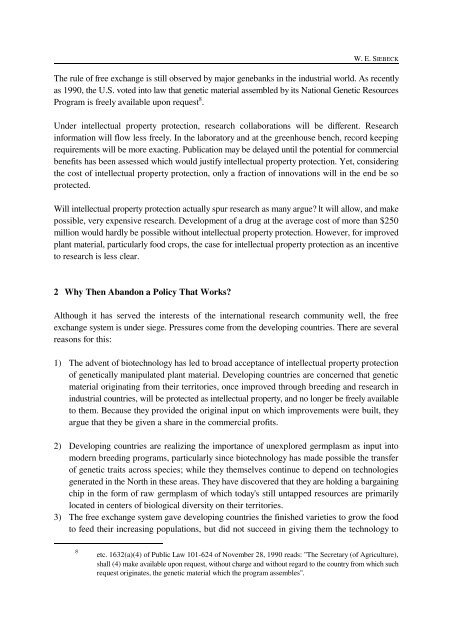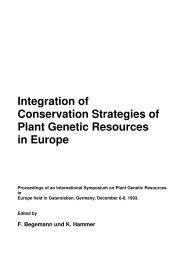Zugang zu Pflanzengenetischen Ressourcen für die ... - Genres
Zugang zu Pflanzengenetischen Ressourcen für die ... - Genres
Zugang zu Pflanzengenetischen Ressourcen für die ... - Genres
Erfolgreiche ePaper selbst erstellen
Machen Sie aus Ihren PDF Publikationen ein blätterbares Flipbook mit unserer einzigartigen Google optimierten e-Paper Software.
W. E. SIEBECK<br />
The rule of free exchange is still observed by major genebanks in the industrial world. As recently<br />
as 1990, the U.S. voted into law that genetic material assembled by its National Genetic Resources<br />
Program is freely available upon request 8 .<br />
Under intellectual property protection, research collaborations will be different. Research<br />
information will flow less freely. In the laboratory and at the greenhouse bench, record keeping<br />
requirements will be more exacting. Publication may be delayed until the potential for commercial<br />
benefits has been assessed which would justify intellectual property protection. Yet, considering<br />
the cost of intellectual property protection, only a fraction of innovations will in the end be so<br />
protected.<br />
Will intellectual property protection actually spur research as many argue? lt will allow, and make<br />
possible, very expensive research. Development of a drug at the average cost of more than $250<br />
million would hardly be possible without intellectual property protection. However, for improved<br />
plant material, particularly food crops, the case for intellectual property protection as an incentive<br />
to research is less clear.<br />
2 Why Then Abandon a Policy That Works?<br />
Although it has served the interests of the international research community well, the free<br />
exchange system is under siege. Pressures come from the developing countries. There are several<br />
reasons for this:<br />
1) The advent of biotechnology has led to broad acceptance of intellectual property protection<br />
of genetically manipulated plant material. Developing countries are concerned that genetic<br />
material originating from their territories, once improved through breeding and research in<br />
industrial countries, will be protected as intellectual property, and no longer be freely available<br />
to them. Because they provided the original input on which improvements were built, they<br />
argue that they be given a share in the commercial profits.<br />
2) Developing countries are realizing the importance of unexplored germplasm as input into<br />
modern breeding programs, particularly since biotechnology has made possible the transfer<br />
of genetic traits across species; while they themselves continue to depend on technologies<br />
generated in the North in these areas. They have discovered that they are holding a bargaining<br />
chip in the form of raw germplasm of which today's still untapped resources are primarily<br />
located in centers of biological diversity on their territories.<br />
3) The free exchange system gave developing countries the finished varieties to grow the food<br />
to feed their increasing populations, but did not succeed in giving them the technology to<br />
8<br />
etc. 1632(a)(4) of Public Law 101-624 of November 28, 1990 reads: "The Secretary (of Agriculture),<br />
shall (4) make available upon request, without charge and without regard to the country from which such<br />
request originates, the genetic material which the program assembles".










